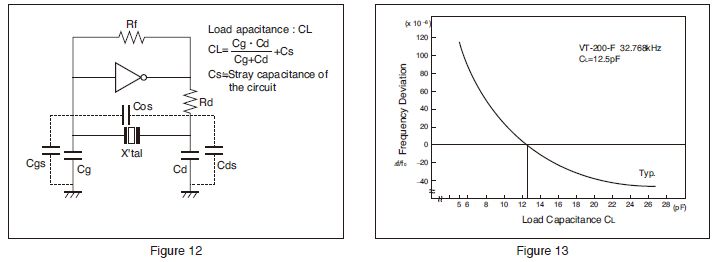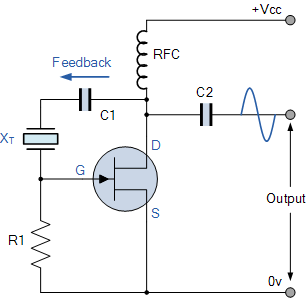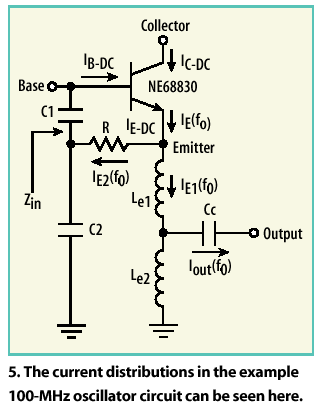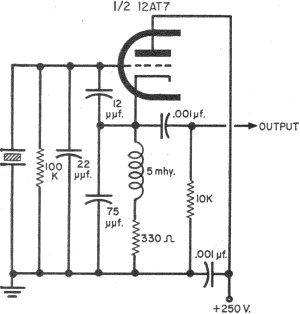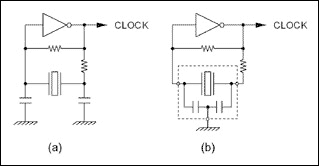
Advantages and challenges of third-overtone IC crystals
.jpg)
Integrated circuits (ICs) with on-board oscillators that require low-frequency fundamental crystals are common; however, IC frequency multipliers now require the higher frequencies provided by third overtone crystals. The third-overtone (3OT) crystal oscillator is more complex than its fundamental counterpart, featuring different crystal characteristics, additional reactive elements, and higher gain. Most crystals utilize the fundamental thickness-shear vibration mode of AT-cut quartz, with a practical upper limit of around 50 MHz for fundamental operation due to the inverse relationship between thickness and frequency. Although a few manufacturers can produce fundamental crystals up to 600 MHz or more using the inverted mesa process, 3OT crystals are more widely available. The 3OT mode resonates at three times the fundamental frequency, and an infinite number of odd harmonics exist on the same quartz plate. The first, third, and fifth harmonics are accompanied by anharmonic modes or spurs, which are minimized by quality crystal manufacturers. The AT-cut crystal's equivalent circuit consists of a series RLC for the fundamental and each harmonic mode, along with a parallel capacitor, C0, due to the electrodes. The series resistance (Rs) of the 3OT is over three times that of the fundamental mode, while its series capacitance (Cs) is nine times less. This lower Cs complicates tuning or calibration in the oscillator, as a significant deviation from the nominal frequency reduces the likelihood of electrical correction. The 3OT offers a higher Q factor, which is crucial alongside its elevated frequency, leading to improved jitter and phase noise characteristics. The structural integrity of the 3OT plate is robust, being one-third the thickness of its fundamental counterpart, and it exhibits excellent aging properties. A 3OT oscillator design is inherently more complex. Typically, a crystal oscillator operates on the fundamental frequency, as it represents the lowest resistance mode. For operation on the 3OT, the fundamental frequency must be suppressed. The top circuit in the associated figure depicts a fundamental Pierce crystal oscillator, a stable and widely used configuration for IC oscillators, comprising an inverting linear amplifier and two PI capacitors, C1 and C2, positioned around the crystal. The resistor can either function independently or represent the output resistance of the inverter. The crystal is calibrated to work with a capacitive load, appearing slightly inductive, which allows it to resonate with the two PI capacitors, effectively in series from an AC perspective. A total phase shift of 360 degrees is necessary to satisfy one of Barkhausen's criteria for oscillation. The inverter provides more than 180 degrees of phase lag, the R-C network contributes slightly less than 90 degrees, and the crystal, operating inductively with the second PI capacitor, adds just over 90 degrees. Adequate gain to surpass the crystal's resistance and appropriate feedback elements satisfy the second Barkhausen criterion, enabling oscillation. The lower circuit in the figure illustrates a 3OT oscillator with a fundamental rejection circuit, where an LC tank replaces the first PI capacitor from the fundamental oscillator. This tank is designed to be capacitive at the 3OT frequency and inductive at the lower fundamental frequency, preventing the fundamental mode from oscillating due to insufficient phase shift around the loop, while allowing the 3OT conditions to be met. Oscillation can occur if the gain surpasses the increased resistance associated with the 3OT crystal. An alternative approach involves incorporating a high-pass filter with the amplifier, which reduces gain at the fundamental frequency while maintaining sufficient gain at the 3OT frequency. This configuration may eliminate the need for an LC selector network, although multiple ICs with varying high-pass filters may be necessary to accommodate a wide frequency range. The PI capacitors are integrated within the IC, requiring only the external crystal. Additionally, 3OT IC oscillators may include integrated inductors for the tank circuits to select the 3OT or to create high-pass filters for fundamental rejection. The increased gain, often referred to as negative resistance, is essential for the 3OT due to its higher resistance. However, negative resistance is not uniform across a frequency range, necessitating that the IC manufacturer ensures adequate gain at the desired frequency and sufficient gain with C0 across its terminals. Insufficient gain may lead to starting issues, and the required gain can be computed using a specific formula.ICs with on-board oscillators requiring low-frequency fundamental crystals are commonplace, but nowG‚IC frequency multipliers require the higher frequencies of third overtone crystals. Compared to its fundamental implementation however, the third-overtone (3OT) crystal oscillator is more complex, with different crystal characteristics plus additio
nal reactive elements and higher gain. Most crystals use the fundamental thickness-shear vibration mode of AT-cut quartz. The practical upper limit of fundamental operation is around 50 MHz because the fundamental resonant frequency is inversely proportional to thickness. Frequencies higher than 50 MHz become too thin to handle during the manufacturing process. While a few crystal manufacturers can make fundamental crystals to 600 MHz or more using the inverted mesa process, 3OT manufacturers are more prevalent.
The 3OT is a crystal mode that resonates at three times its fundamental frequency. There are in fact an infinite number of odd harmonics that exist on the same quartz plate. The first, third and fifth harmonics are shown in Figure 1a with some anharmonic modes or spurs shown in between. Spurs are by-products of other vibrational modes and a good crystal manufacturer makes sure that these are minimized.
G‚ The AT-cut crystal has the equivalent circuit (see Fig. 1b) of a series RLC for the fundamental and each harmonic mode plus a capacitor, C0, in parallel due to the electrodes. The 3OT series resistance, Rs, is more than three times that of the fundamental mode. Its series capacitance, Cs, is nine times less. This lower Cs in the 3OT will make tuning or calibration harder in the oscillator. If the crystal is too far off nominal frequency, there is less chance to electrically correct this in the oscillator.
The 3OT has higher Q, which is the most important feature next to its higher frequency, as it results in better jitter and phase noise. Because the 3OT plate is as thick as a fundamental one-third its frequency, it is structurally robust with very good aging characteristics.
G‚G‚G‚G‚G‚G‚G‚G‚G‚G‚G‚G‚G‚G‚G‚G‚G‚G‚G‚G‚G‚G‚G‚G‚G‚G‚G‚G‚G‚G‚G‚G‚G‚G‚G‚G‚G‚G‚G‚G‚G‚G‚G‚G‚G‚G‚G‚G‚G‚G‚G‚G‚G‚G‚G‚G‚G‚G‚G‚ G‚G‚G‚G‚G‚G‚G‚G‚G‚G‚G‚G‚G‚G‚G‚G‚G‚G‚G‚G‚G‚G‚ Fig. 1: The first, third, and fifth harmonics are shown inG‚(a) with some anharmonic modes or spurs shown in-between.
The AT-cut crystal has the equivalent circuit, shown in (b), of a series RLC for the fundamental and each harmonic mode plus a capacitor, C0, in parallel due to the electrodes. A 3OT oscillator design is more complicated. In general a crystal oscillator will always run on the fundamental, as it is the lowest resistance mode.
While the 3OT has the next lowest mode in resistance, to operate on it, the fundamental must be suppressed. In Fig. 2 the top circuit is a fundamental Pierce crystal oscillator, a stable and common configuration for IC oscillators.
It consists of an inverting linear amplifier and two `PI` capacitors, C1 and C2, on either side of the crystal. The resistor shown can standalone or represent the output resistance of the inverter. The crystal is calibrated to operate with a capacitive load so it looks slightly inductive and therefore resonates with the two PI caps - which from an AC point of view are in series.
Around the loop there is 360G‚ ° of phase shift to meet one of Barkhausen`s criteria. The inverter contributes a little more than 180G‚ ° phase lag, the R-C accounts for a little less than 90G‚ °, and the crystal (operating inductively) with the second PI cap, contributes a little more than 90G‚ °. With enough gain to overcome the crystal resistance, and feedback elements, it meets the second of Barkhausen`s criterion and it will oscillate.
Fig. 2: In (a) the Pierce crystal oscillator is considered a stable and common configuration for IC oscillators. In (b) is a 3OT oscillator with a fundamental rejection circuit. The bottom circuit of Fig. 2 is a 3OT oscillator with a fundamental rejection circuit. An LC tank replaces the first PI capacitor in the fundamental oscillator. The tank is designed to be capacitive at the 3OT frequency and inductive at the lower fundamental frequency.
In this way, the fundamental mode will not run because the phase shifts around the loop will not add up to be 360G‚ °, but the phase conditions for the 3OT will be correct when the tank is capacitive. Oscillation will occur provided that there is sufficient gain to overcome the increased resistance of the 3OT crystal.
Another option is to put a high-pass filter in with the amplifier, starving the gain at the fundamental but allowing sufficient gain at the 3OT frequency. In this way an LC selector network is unnecessary though it may take more than one IC with different high pass filters to cover wide frequency ranges.
The PI caps are built into the IC so only the crystal is required externally. 3OT IC oscillators also integrate inductors for the tanks to select the 3OT or create high pass filters to reject the fundamental. Increased gain, commonly referred to as negative-R, is required for the 3OT because of the higher resistance.
Negative-R however is not flat across a frequency range. The IC manufacturer must not only guarantee that there is enough gain at the desired frequency, but there must be enough gain with C0 across its terminals. Too little gain may cause starting problems. The required gain can be calculated with the following formula. 🔗 External reference
nal reactive elements and higher gain. Most crystals use the fundamental thickness-shear vibration mode of AT-cut quartz. The practical upper limit of fundamental operation is around 50 MHz because the fundamental resonant frequency is inversely proportional to thickness. Frequencies higher than 50 MHz become too thin to handle during the manufacturing process. While a few crystal manufacturers can make fundamental crystals to 600 MHz or more using the inverted mesa process, 3OT manufacturers are more prevalent.
The 3OT is a crystal mode that resonates at three times its fundamental frequency. There are in fact an infinite number of odd harmonics that exist on the same quartz plate. The first, third and fifth harmonics are shown in Figure 1a with some anharmonic modes or spurs shown in between. Spurs are by-products of other vibrational modes and a good crystal manufacturer makes sure that these are minimized.
G‚ The AT-cut crystal has the equivalent circuit (see Fig. 1b) of a series RLC for the fundamental and each harmonic mode plus a capacitor, C0, in parallel due to the electrodes. The 3OT series resistance, Rs, is more than three times that of the fundamental mode. Its series capacitance, Cs, is nine times less. This lower Cs in the 3OT will make tuning or calibration harder in the oscillator. If the crystal is too far off nominal frequency, there is less chance to electrically correct this in the oscillator.
The 3OT has higher Q, which is the most important feature next to its higher frequency, as it results in better jitter and phase noise. Because the 3OT plate is as thick as a fundamental one-third its frequency, it is structurally robust with very good aging characteristics.
G‚G‚G‚G‚G‚G‚G‚G‚G‚G‚G‚G‚G‚G‚G‚G‚G‚G‚G‚G‚G‚G‚G‚G‚G‚G‚G‚G‚G‚G‚G‚G‚G‚G‚G‚G‚G‚G‚G‚G‚G‚G‚G‚G‚G‚G‚G‚G‚G‚G‚G‚G‚G‚G‚G‚G‚G‚G‚G‚ G‚G‚G‚G‚G‚G‚G‚G‚G‚G‚G‚G‚G‚G‚G‚G‚G‚G‚G‚G‚G‚G‚ Fig. 1: The first, third, and fifth harmonics are shown inG‚(a) with some anharmonic modes or spurs shown in-between.
The AT-cut crystal has the equivalent circuit, shown in (b), of a series RLC for the fundamental and each harmonic mode plus a capacitor, C0, in parallel due to the electrodes. A 3OT oscillator design is more complicated. In general a crystal oscillator will always run on the fundamental, as it is the lowest resistance mode.
While the 3OT has the next lowest mode in resistance, to operate on it, the fundamental must be suppressed. In Fig. 2 the top circuit is a fundamental Pierce crystal oscillator, a stable and common configuration for IC oscillators.
It consists of an inverting linear amplifier and two `PI` capacitors, C1 and C2, on either side of the crystal. The resistor shown can standalone or represent the output resistance of the inverter. The crystal is calibrated to operate with a capacitive load so it looks slightly inductive and therefore resonates with the two PI caps - which from an AC point of view are in series.
Around the loop there is 360G‚ ° of phase shift to meet one of Barkhausen`s criteria. The inverter contributes a little more than 180G‚ ° phase lag, the R-C accounts for a little less than 90G‚ °, and the crystal (operating inductively) with the second PI cap, contributes a little more than 90G‚ °. With enough gain to overcome the crystal resistance, and feedback elements, it meets the second of Barkhausen`s criterion and it will oscillate.
Fig. 2: In (a) the Pierce crystal oscillator is considered a stable and common configuration for IC oscillators. In (b) is a 3OT oscillator with a fundamental rejection circuit. The bottom circuit of Fig. 2 is a 3OT oscillator with a fundamental rejection circuit. An LC tank replaces the first PI capacitor in the fundamental oscillator. The tank is designed to be capacitive at the 3OT frequency and inductive at the lower fundamental frequency.
In this way, the fundamental mode will not run because the phase shifts around the loop will not add up to be 360G‚ °, but the phase conditions for the 3OT will be correct when the tank is capacitive. Oscillation will occur provided that there is sufficient gain to overcome the increased resistance of the 3OT crystal.
Another option is to put a high-pass filter in with the amplifier, starving the gain at the fundamental but allowing sufficient gain at the 3OT frequency. In this way an LC selector network is unnecessary though it may take more than one IC with different high pass filters to cover wide frequency ranges.
The PI caps are built into the IC so only the crystal is required externally. 3OT IC oscillators also integrate inductors for the tanks to select the 3OT or create high pass filters to reject the fundamental. Increased gain, commonly referred to as negative-R, is required for the 3OT because of the higher resistance.
Negative-R however is not flat across a frequency range. The IC manufacturer must not only guarantee that there is enough gain at the desired frequency, but there must be enough gain with C0 across its terminals. Too little gain may cause starting problems. The required gain can be calculated with the following formula. 🔗 External reference
